 | ||
A supersonic wind tunnel is a wind tunnel that produces supersonic speeds (1.2
Contents
Minimum required pressure ratio
Optimistic estimate: Pressure ratio
Examples:
Temperature effects: condensation
Temperature in the test section:
with
The velocity range is limited by reservoir temperature
Power requirements
The power required to run a supersonic wind tunnel is enormous, of the order of 50 MW per square meter of test section cross-sectional area. For this reason most wind tunnels operate intermittently using energy stored in high-pressure tanks. These wind tunnels are also called intermittent supersonic blowdown wind tunnels (of which a schematic preview is given below). Another way of achieving the huge power output is with the use of a vacuum storage tank. These tunnels are called indraft supersonic wind tunnels, and are seldom used because they are restricted to low Reynolds numbers. Some large countries have built major supersonic tunnels that run continuously; one is shown in the photo. Other problems operating a supersonic wind tunnel include:
Tunnels such as a Ludwieg tube have short test times (usually less than one second), relatively high Reynolds number, and low power requirements.
